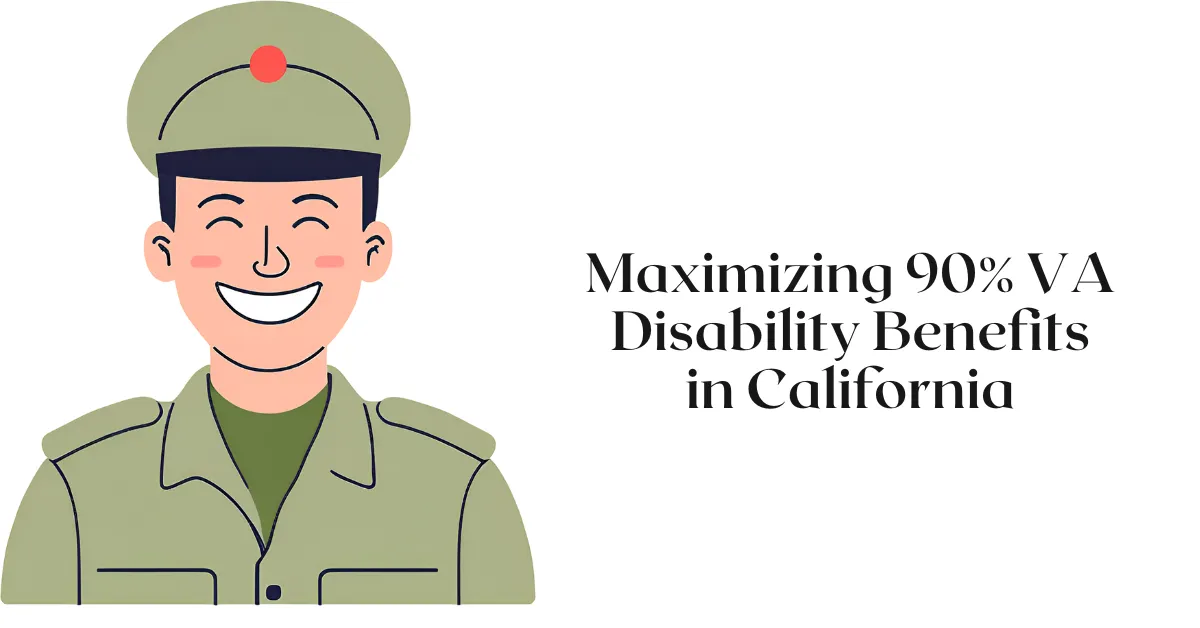If you have a 90% VA disability rating, you’re receiving significant compensation. However, you might still feel the gap between what you get and a full 100% rating.
Fortunately, there are ways to maximize your benefits and take advantage of California-specific programs that can help.
From property tax exemptions to education assistance, California offers several benefits to veterans with a high disability rating.
Understanding how VA compensation works at the 90% level and how to increase or supplement it is key. Let’s break down everything you need to know to get the most out of your benefits in 2025.
Understanding a 90% VA Disability Rating
Reaching a 90% VA disability rating means you have multiple service-connected conditions, but you’re just shy of 100% compensation. The biggest challenge? VA math. Instead of simple addition, the VA uses a complex formula that makes reaching 100% difficult.
For 2025, a single veteran at 90% disability receives $2,297.96 per month. Of course, they can receive a higher amount when dependents are involved. While this is a substantial amount, it’s still nearly $1,500 less than a 100% rating provides ($3,831.30).
Since moving from 90% to 100% requires proving worsening conditions or new disabilities, many veterans explore Total Disability Individual Unemployability (TDIU), which grants 100% benefits if you can’t maintain substantial work.
Others file for rating increases by submitting new medical evidence. Understanding how to increase your rating or maximize your existing benefits strategically is key to financial stability.
VA Compensation and Additional Financial Benefits in California
Even at 90% disability, you may qualify for additional financial benefits at both the federal and state levels. These can help offset costs and improve your quality of life.
- Federal Compensation: As of 2025, a single veteran at 90% receives $2,297.96, with additional pay for dependents.
You may also be eligible for Special Monthly Compensation (SMC) if you have severe disabilities, such as loss of limb function or the need for daily aid.
- State-Specific Benefits in California: California provides a Disabled Veterans’ Property Tax Exemption, reducing or eliminating property taxes for qualifying veterans.
Veterans at 90% disability can also receive employment benefits, such as hiring preference for state jobs and business tax breaks.
Additionally, you may qualify for reduced-cost college tuition for dependents, discounted vehicle registration fees, and free access to state parks and fishing licenses.
California-Specific Benefits for 90% Disabled Veterans
California provides exclusive benefits that can significantly improve your financial situation as a 90% disabled veteran. These state programs help with housing, education, employment, and daily living costs.
- Property Tax Exemption: California offers a Disabled Veterans’ Property Tax Exemption, which can reduce or eliminate property taxes if you meet income limits.
- Education Benefits: If you have a dependent child, they may qualify for CalVet’s College Fee Waiver, which covers tuition at state schools like UCs, CSUs, and community colleges.
- Employment & Business Support: Veterans get hiring preference for state jobs and may qualify for business tax incentives and small business support programs.
- Transportation & Recreation Discounts: You can receive reduced vehicle registration fees, a free state park pass, and discounted fishing/hunting licenses.
- Healthcare & Long-Term Care: California Veterans Homes offers affordable care for assisted living or skilled nursing. These facilities provide medical support, rehabilitation, and community living.
How to Increase a 90% VA Disability Rating to 100%
If you’re at 90% disability, moving to 100% can be challenging, but it’s possible through rating increases or TDIU. Here’s what you need to know.
- Filing for a Rating Increase: If a service-connected condition has worsened, submit a claim for an increased rating. Use current medical records, doctor’s statements, and disability impact reports to strengthen your case.
- Adding Secondary Conditions: Many veterans overlook secondary conditions linked to existing disabilities.
For example, sleep apnea, migraines, or mental health disorders might stem from service-connected injuries. Filing for these conditions can push your combined rating to 100%.
- Applying for TDIU: If your disability prevents you from working, you may qualify for TDIU. This benefit pays at a 100% compensation even if your rating is below 100%.
To be eligible, you generally need one condition rated at 60% or a combined rating of 70% with one condition at 40%.
- Using Buddy Statements & Nexus Letters: Statements from family, fellow service members, or medical professionals can support your claim. A nexus letter from a doctor linking your condition to service can be game-changing.
Additional Resources and Support for California Veterans
California has numerous resources to assist veterans in navigating benefits, legal claims, and financial aid. These services help you maximize what’s available.
- CalVet Services: The California Department of Veterans Affairs (CalVet) provides housing programs, employment support, and benefits assistance.
- Veterans Service Organizations (VSOs): Groups like the VFW, DAV, and American Legion offer free VA claims assistance and can help with rating increases and appeals.
- County Veterans Service Offices (CVSOs): Every county in California has a CVSO, where trained representatives can review your case, file claims, and connect you to resources.
- Legal & Financial Assistance: Organizations like Bay Area Legal Aid and Veterans Legal Institute provide free or low-cost legal help for VA claims, housing disputes, and benefits issues.
Conclusion
A 90% VA disability rating provides significant compensation.
California offers unique programs, such as property tax exemptions, education assistance, and healthcare support, that can ease financial burdens.
Additionally, resources like CalVet, VSOs, and legal aid can help you navigate the VA system more effectively.
Going for some of the benefits may feel complex, considering the layers or steps in the submission process. However, you can always seek help from the VSO, CVSOs, or other legal assistant.
